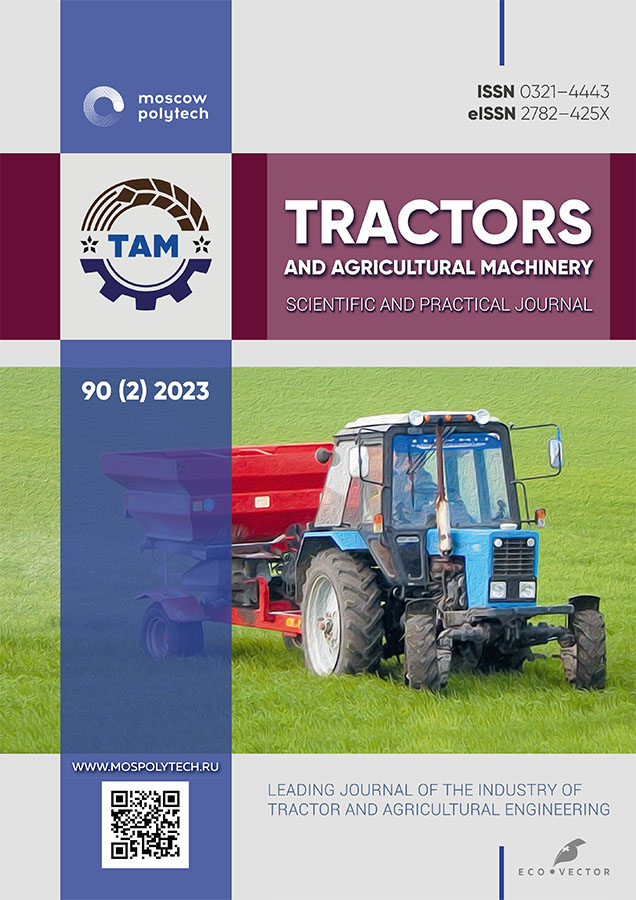Synthesis of an adaptive observer of the resistance torque at a shaft of a traction electric motor
- 作者: Klimov A.V.1,2
-
隶属关系:
- KAMAZ Innovation Center, Skolkovo Innovation Center
- Moscow Polytechnic University
- 期: 卷 90, 编号 2 (2023)
- 页面: 99-105
- 栏目: New machines and equipment
- ##submission.dateSubmitted##: 21.12.2022
- ##submission.dateAccepted##: 27.05.2023
- ##submission.datePublished##: 27.07.2023
- URL: https://journals.eco-vector.com/0321-4443/article/view/119856
- DOI: https://doi.org/10.17816/0321-4443-119856
- ID: 119856
如何引用文章
详细
BACKGROUND: Operating companies and consumers have demands to vehicles for efficiency improvement and cost cut. A part of substantial expenses is fuel cost, therefore use of vehicles with electric drive such as hybrid or pure electric (battery-electric) has potential for agriculture. It is mainly important for them to have the drivetrain characterized by high efficiency that increases autonomous mileage for one charge. To achieve this, it is necessary to control electric motors in the way to ensure maximal surface grip coefficient without wheel slipping. In this case, real-time defining of wheel resistance torque in necessary for efficient control.
AIMS: Development of the theoretical basis and the law of optimal estimation of the resistance torque at a shaft of traction electric motor of transport vehicles for the sake of efficient control of traction electric drive.
METHODS: Simulation of the law of optimal estimation of the resistance torque at a shaft of traction electric motor was carried out in the MATLAB/Simulink software package.
RESULTS: The article provides with theoretical basis of formatting the law of optimal estimation of the resistance torque at a shaft of traction electric motor of transport vehicles for the sake of efficient control of traction electric drive, the law of optimal estimation of the resistance torque at a shaft of traction electric motor and the results of simulation of the law of optimal estimation of the resistance torque at a shaft of traction electric motor obtained in the MATLAB/Simulink.
CONCLUSIONS: Practical value of the study lies in ability of using the proposed control laws for development of transport vehicles drivetrain control system.
全文:
作者简介
Aleksandr Klimov
KAMAZ Innovation Center, Skolkovo Innovation Center; Moscow Polytechnic University
编辑信件的主要联系方式.
Email: Aleksandr.Klimov@kamaz.ru
ORCID iD: 0000-0002-5351-3622
SPIN 代码: 7637-3104
Cand. Sci. (Tech.), Head of the Electric Vehicles Department
俄罗斯联邦, Moscow; Moscow参考
- Andryushchenko VA. Theory of automatic control systems: Textbook. Leningrad: Izd-vo Leningradskogo un-ta; 1990. (in Russ.)
- Aliev FA, Larin VB, Naumenko KI, et al. Optimization of linear time-invariant control systems. Kyev: Naukova dumka; 1978. (in Russ.)
- Ivanov VA, Faldin FV. Theory of optimal automatic control systems. Moscow: Nauka, 1981. (in Russ.)
- Afanasiev BA, Belousov BN, Zheglov LF. Designing of all-wheel drive wheeled vehicles: a textbook for high schools; in 3 Vols. Vol. 3. Moscow: MGTU im NE Baumana; 2008. (in Russ.)
- Polungyan AA, Fominykh AB, Staroverov NN. Dynamics of wheeled vehicles: textbook. Part 1. Moscow: MGTU im NE Baumana; 2013. (in Russ.)
- Zhileikin MM, Kotiev GO. Vehicle Systems Modeling: Tutorial. Moscow: MGTU im NE Baumana; 2020. (in Russ.)
补充文件









